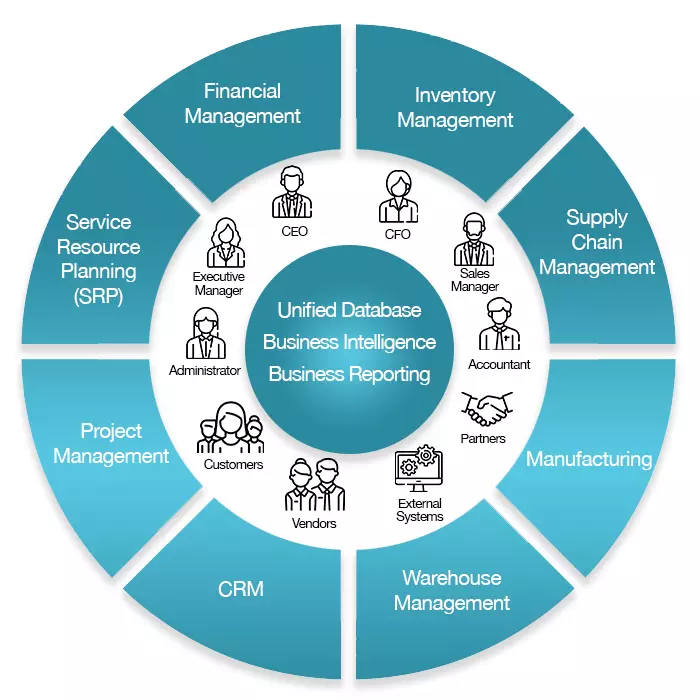
A CFO and CIO guide to business intelligence and analytics
The importance of extracting the right information from your business to make informed decisions cannot be underestimated. A recent study by S&P Global revealed that an estimated 25% of enterprise businesses say their decisions are driven by data, while 90% of businesses have indicated that data is increasingly important to their operational performance.
So how do you go from making assumptions from out-of-date reports, gutfeel, and internal biases to leveraging your data business to find success? Especially when the volume of data generated from various sources is enormous.
In this article I explain the utilisation of ERP data for business intelligence and analytics and demonstrate how you can use this information to enable you to make data-driven decisions that align with the needs of your business.
Understanding ERP data
ERP systems are designed to collect and store data from different business units. This data includes financial transactions, sales figures, inventory levels, production data, and much more. The data collected by ERP systems is critical to the functioning of any business.
Identifying the many types of data that your ERP system generates is essential for taking full advantage of your ERP data. Some of the common types of ERP data include:
- Transactional data: Refers to the various financial transactions that occur within the business, such as sales, purchases, and payments.
- Master data: Refers to the reference data that is used throughout the business, such as customer information, product information, and vendor information.
- Production data: Includes information about the production process, including inventory levels, production schedules, and work orders.
- Supply chain data: Includes information including supplier information, order tracking, and delivery information.
By understanding the different types of data that your ERP system generates is essential so you can take full advantage of the gold that lies within your ERP data.
Tools and techniques for maximising the value of ERP data in BI and analytics
To make the most of ERP data, it is important to prioritise and concentrate on three key areas:
- Data Quality: Accurate business intelligence and analytics depend on having quality data. To accurately generate insights, your data must stay clean, consistent, and current.
- Analytics: Once your data is of high quality, you can begin to use it for analytics. This involves using tools like dashboards, scorecards, and reports to gain insights into key business metrics.
- Decision-Making: The last step is to use the insights gained from your data to make informed business decisions. This involves using the data to identify trends, opportunities, and potential risks.
Using a data warehousing and business intelligence (BI) software solution tailored to integrate with your ERP system could prove to be an excellent way of unlocking valuable insights from ERP data. This will allow you to move, modify, and transfer ERP data into a single repository where it can be quickly and easily accessed, analysed, and represented visually.
How to uncover insights and driving action with ERP data
1. Extract: Use ETL (Extract, Transform, Load) tools or other data integration methods to extract your ERP data and move it into a data warehouse.
2. Transform: Clean, standardise, and transform your ERP data into a suitable format for analysis.
3. Load: Populate your transformed ERP data into the data warehouse, where it can be stored and easily accessed by your BI and analytics tools.
4. Analyse: Business Intelligence (BI) and analytics tools can be of great benefit when it comes to enhancing your understanding of ERP data. Among the suite of features offered by these tools, you have access to powerful visualisations, reporting capabilities, and convenient data discovery.
5. Visualise: Create interactive dashboards and reports that allow you to easily view and understand your ERP data.
6. Communicate: Communicate the insights and key findings to the relevant stakeholders.
Harnessing the power of up-to-date information
To ensure the highest results, here are some effective strategies to keep in mind:
1. Define Your Metrics: Clearly define the metrics you want to track and analyse so you can focus on the important factors for your business while avoiding the irrelevant information that leads you down a never-ending rabbit-hole.
2. Use Real-Time Data: Real-time data is critical for making informed decisions quickly. Ensure your ERP system is set up to provide real-time data to your business intelligence and analytics tools.
3. Invest in Analytics Tools: Investing in the right analytics tools can make a big difference in the effectiveness of your business intelligence and analytics efforts. To optimise the effectiveness of your ERP system, it is essential to find tools that can be navigated with ease, deliver useful data and information, and integrate smoothly. Doing so will allow for a much more efficient workflow.
4. Get Buy-In from Stakeholders: To ensure the success of your business intelligence and analytics initiatives, it is essential to get buy-in from stakeholders across the business. This includes executives, managers, and front-line employees.
ERP systems featuring embedded BI and analytics are becoming increasingly popular, which eliminates the need to have a separate data warehousing solution. However, you do have to perform ETL operations to use the data collected from the ERP system.
When it comes to the most effective method, the answer is determined by your organisation’s necessities, the BI and analytics programmes that are available to you, and your team’s technical capabilities.
Transforming raw ERP data into actionable insights
By using predictive analytics, you can speed up and improve your decision-making capabilities to find ways that will improve your business, identify new opportunities, cost savings, while streamlining your business’ operations.
It is crucial to success that you gain a deep understanding of your data, so you can make the most of it.
ERP analytics is the process of extracting, transforming, loading, and analysing data from an Enterprise Resource Planning (ERP) system, such as NetSuite. This process can shed light on the complex relationships between a business’ processes, people, products, and customers. With the right tools, you can gain a comprehensive view of your NetSuite data and uncover crucial insights that can help you make better decisions and increase business efficiency.
You may need to use a third-party BI tool specifically designed to integrate with NetSuite. When it comes to selecting the right BI and analytics tools for your organisation, there are three important considerations you must make:
1. The specific needs of your organisation,
2. The BI and analytics tools that are available to you, and
3. Your team’s technical expertise.
Advantages of using NetSuite Analytics Warehouse
By leveraging NetSuite Analytics, businesses can gain a wide range of benefits that extend across their entire operations.

- Financial Management: With NetSuite’s real-time financial data, businesses can track their financial performance, monitor cash flow, and manage financial operations more efficiently.
- Forecasting: NetSuite’s forecasting tools enable businesses to predict trends and plan for the future, allowing them to anticipate market shifts and adapt to changing conditions more effectively.
- Budgeting: By using NetSuite for budgeting, businesses can create more accurate budgets based on real-time financial data, track spending against budgets, and adjust budgets as needed, providing more control over financial operations.
- Supply Chain: NetSuite’s supply chain management tools help businesses optimise their inventory levels, reduce lead times, and improve supplier management, allowing for better control over the supply chain and improved relationships with suppliers.
- Warehousing: With NetSuite’s warehouse management tools, businesses can streamline their warehouse operations, manage inventory levels more effectively, and reduce costs associated with managing warehouses.
- Logistics: NetSuite’s logistics management tools allow businesses to optimise their transportation networks, improve delivery times, and reduce shipping costs, providing greater efficiency and cost savings.
- Production: By using NetSuite for production planning and management, businesses can improve their production processes, reduce costs, and ensure that production schedules are aligned with customer demand, providing greater efficiency and better customer service.
- Procurement: NetSuite’s procurement tools help businesses manage the entire procurement process, from sourcing suppliers to creating purchase orders and paying invoices, improving visibility, and reducing the risk of errors.
Conclusion
Today, data can be utilised to gain a competitive edge by building an effective data plan to make better decisions on various things like product releases, brand communication and more. A company that relies solely on assumptions will not survive when trends change rapidly. Fortunately, with technology there is a better way.
Analytics and business intelligence are critical to sound decision-making, and ERP data can be instrumental in helping you do this. It is paramount to understand the kinds of information produced by your ERP system, maintain good data quality, incorporate analytics tools into the process, plus secure support from those involved. Adopting these steps will let you use ERP data to better comprehend key business metrics and expose any potential trends, chances or dangers that could arise.
So, start using your ERP data for business intelligence and analytics today and take your business and ERP reports to the next level.
Take control of your success with Oracle NetSuite and OneKloudX
At OneKloudX, we understand that Oracle NetSuite has the power to transform businesses. That’s why our experts have helped countless companies harness that power and use it to their advantage. We bring decades of business-process expertise and unmatched product knowledge to every engagement, ensuring that our clients get the most out of NetSuite. From implementations and customisation to integration and refinement, we’re here to help you streamline your back-end operations for maximum efficiency.
Our award-winning team helps you get the most value from NetSuite, so you can focus on what really matters – your customers, your people and your business.
We are here to answer your questions. If you are ready, schedule a demo using our calendar, or call us on 1800 155 683. If not, check out our complimentary whitepapers.







